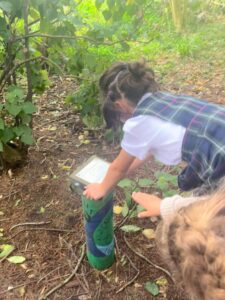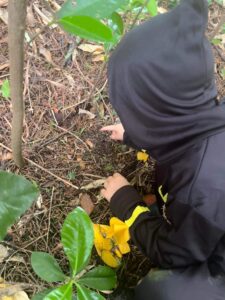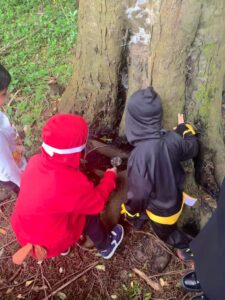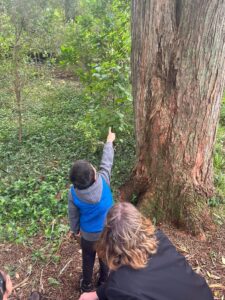How did it come about?
The idea of a School ngahere experience came from the Enviroschools Ecological Building workshop I attended. I had some ideas about building huts in our ngahere and had been talking to teachers at the hui who had been taking children into local forests and had bush schools. I was excited because we have a ngahere at school and wondered how it could be utilised for a nature connection experience. Normally school tikanga is that children are only allowed on the boardwalk, and not allowed in amongst the bush, but I thought we could make an exception for this special experience. What if we could take children in for supervised and purposeful, but not structured time? It also happened to be Outdoor Classroom Day and the Juniors hadn’t been able to participate in a field trip that the Middle and Senior School that had been organised earlier in the year, so I decided to organise something for them.
What happened?
I sent out an email to the Junior teachers inviting them to spend some time with me in the ngahere exploring. I had a timetable to follow, and created a slideshow for teachers with ideas – using mirrors and magnifying glasses, building huts etc. This created a guide for teachers who hadn’t had this sort of experience. I wasn’t going to run it for them but would be there to support the teachers with the kids for free-flowing exploration time in the school ngahere.
I also told the teachers to do nothing – just observe. But for those children who are really struggling to self- orientate or get started, then we could leave some equipment out and see what they do with it. That’s pretty much what we did.

Re-discovering the painted pou.

I can see a tiny bug!

Quiet observation.
It became apparent that particularly the younger kids didn’t know how to self-play, other than a couple of the boys who got sticks and started digging, they were all just following the teacher around. The teacher started saying things like “Oh look at this over here . . .” and direct their attention to something and all of that’s great because it’s all vocabulary and oral language and all that, but what I really wanted them to do was to leave the kids alone and let them discover for themselves.
I put out some magnifying glasses and some mirrors and they picked them up and found some cool things. They were looking in the trees, and finding some bugs and there was lots of oral language going on. I also got a bit involved because they were really struggling to direct their own play (which is really interesting). I suppose they are in the school environment, so they are always looking towards the adult.
I started saying things like “I wonder if there is a spikey leaf in the ngahere?”, “I wonder if there’s a shiny leaf?” They’d then go and have a look at the leaves, and some would come back, and some wouldn’t. Some would find other things to do. There was some digging, lots of asking questions about the bugs, about what was making the trees wave in the wind and lots of observations. They saw some blue ladybugs that they hadn’t come across before. They were pretty excited about that! They were also engaging in the things that had been there forever, like the painted Pou. It was really cool! They were discovering bugs and spiders, and we could talk about worms and how they were good for the soil. They were also looking at bark, and shapes of leaves and textures of leaves.
I noticed the teacher would say things like “Oh *Amelia* is getting excited, what are you finding over there?” and it would be an interruption. I would do it too! Then that child would turn around and stop scratching in the dirt and get really self-conscious and then stop. We feel as kaiako, that we need to affirm what they are doing or something.

Who lives here?

Tall trees, big stories.
What could I do differently?

Simple equipment like mirrors and magnifying glasses help slow and focus. (Creative dress-ups were in response to a Halloween day at school).
It was really interesting that a lot of the children found it really hard to be in ngahere amongst the trees on the ground. They kept on jumping back on the boardwalk. They clearly found it uncomfortable in there and they weren’t sure what to do. Next time I’d start the experience by walking through the ngahere with the children, being really clear that for this special nature connection experience normal boundaries of staying on the boardwalk (to protect the plants and animals) did not apply.
The next time I provide the space again I would sit completely out of it and just be there for safety. I’d also let the teachers know, that while they may want to get involved and be the leader and be asking the questions, leave the children alone to develop their own curiosity.
Also, they LOVED the magnifying glasses, so to start I might set them up in pairs, so if they lacked confidence, they could have support from a buddy.